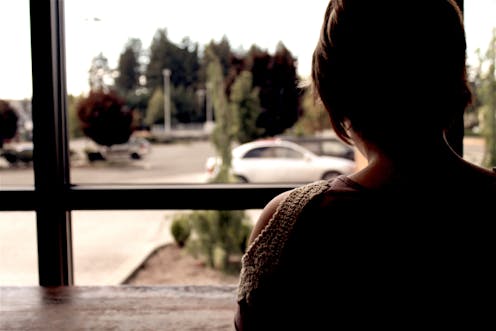Why are rates of domestic violence in Australia still so high?
- Written by Heather Douglas, Professor of Law, The University of Queensland
 One in six Australian women have experienced partner violence.Isaac Holmgren/Unsplash
One in six Australian women have experienced partner violence.Isaac Holmgren/UnsplashAustralian Bureau of Statistics (ABS) data released this week as part of the Personal Safety Study (PSS) reveals 16% of Australian women have experienced partner violence.
The 2016 PSS was conducted across Australia and surveyed around 21,000 people about their experience of violence. The PSS was last run in 2012, and before that in 2005, so it’s possible to make some comparisons across time.
The statistics show a mixed picture. Overall, the proportion of Australians who report that they experienced violence in the past year has declined from 8.3% in 2005 to 5.4% in 2016.
However partner violence remains high, especially towards women.
 ABS
ABSAround one in six women (16% or 1.5 million) have experienced physical violence by a partner, compared with one in seventeen men (5.9% or 528,800).
Read more: Study confirms intimate partner violence leading health risk factor for women
Women were much more likely to experience physical violence from a previous partner than a current one. Around 2.9% of women reported violence by a current partner, while around 14.6% of women experienced violence by a previous partner. There has been little change in the partner violence figures since 2005.
In the last few years, significant resources have been devoted to changing attitudes towards domestic violence – so why aren’t the numbers going down?
One answer may be that broader attitudes towards women and relationships need to change and this takes a long time. Campaigns like Let’s Change the Story and The Line focus on creating the deep and long-lasting cultural change that’s needed but it’s probably still too early to see results.
Another answer might be that some people are changing, and using violence less. But as we talk more about domestic violence, it loses the stigma historically attached to it. As a consequence, more people are prepared to name it and report it. This keeps the figures stable.
The ABS statistics show that higher numbers of women report violence by their intimate partners after separation than during the relationship. This is no surprise. Leaving the relationship may threaten an abuser’s sense of control and violence may be one tactic used in an effort to reassert control or punish the victim for leaving.
Read more: Why doesn’t she just leave? The realities of escaping domestic violence
In 1990, Martha Mahoney coined the term “separation assault” in recognition of the phenomenon. Separation is now a well-known risk factor for heightened violence. In governmentdeath reviews, actual or intended separation is a characteristic of a high proportion of intimate partner homicides.
Risk assessment tools that police and support services use in safety planning now routinely identify separation as a key risk factor for further violence and death.
 As we reduce the stigma of naming domestic violence we may see more women seek help.Annie Spratt/Unsplash
As we reduce the stigma of naming domestic violence we may see more women seek help.Annie Spratt/UnsplashNotably, while the ABS statistics have remained relatively stable, calls on services have increased significantly over recent years. Applications for domestic violence protection orders in Queensland have jumped from 23,794 in 2012-13 to 32,221 in 2015-16 – a 26% rise.
Similarly in Victoria, 74,551 family violence and personal safety matters were heard by the Victorian Magistrates Court in 2015–16. This was a 27% increase since 2011–12.
In Queensland, reports to police of breach of domestic violence protection orders have more than doubled between 2012 and 2017 and these have also increased significantly in Victoria.
According to annual reports, calls for support to Queensland’s domestic violence support line, DVConnect, have tripled between 2012 and 2016. Safesteps, Victoria’s domestic violence support line, has seen a similar increase.
Read more: Deaths after seeking help point to priorities in tackling domestic violence
Given the ABS reports that figures on domestic violence remain relatively stable, why is there such an increase in requests for support and services?
The ABS statistics are collected through a survey and questions about help-seeking are not included.
The increased numbers of applications for protection orders, reports of breach of those orders and increased calls to support services might suggest that people are increasingly willing to seek help in response to the violence they are experiencing.
Perhaps some are choosing to leave their violent partners. Again, this increase in help-seeking may be explained in part by a reduced stigma associated with domestic violence and the increased willingness of people to name it.
Another explanation might be that services are improving their understanding of domestic violence and are getting better at screening for domestic violence and making appropriate referrals.
Whatever the reason for them, the relative stability of the overall statistics in the ABS study leave no room for complacency. The figures remain too high.
As we reduce the stigma of naming domestic violence we may see more women seek help, and when they do they will often be placing themselves at serious risk. We need to continue to develop and resource robust responses to individual perpetrators and appropriate support for victims.
The National Sexual Assault, Family & Domestic Violence Counselling Line – 1800 RESPECT (1800 737 732) – is available 24 hours a day, seven days a week for any Australian who has experienced, or is at risk of, family and domestic violence and/or sexual assault.
Heather Douglas receives funding from the Australian Research Council (FT140100796) She is affiliated with DVConnect.
Authors: Heather Douglas, Professor of Law, The University of Queensland
Read more http://theconversation.com/why-are-rates-of-domestic-violence-in-australia-still-so-high-87187





